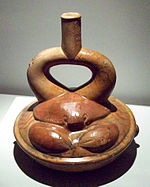Stirrup spout vessel
Appearance

A stirrup spout vessel (so called because of its resemblance to a stirrup) is a type of ceramic vessel common among several Pre-Columbian cultures of South America beginning in the early 2nd millennium BCE.[1]
These cultures included the Chavin and the Moche. In these vessels the stirrup handle actually forms part of the spout, which emanates from the top of the stirrup. The jars, which were often elaborately figurative, would be cast from a mold, while the stirrup spout was built by hand and welded to the vessel with slip.[2]
See also
- Double spout and bridge vessel, another common type of vessel from Pre-Columbian South America
- Stirrup jar, a similarly named vessel of Mediterranean origin
- Moche Crawling Feline
References
- ^ "Stirrup-spout bottle [Peru; Cupisnique] (1978.412.38)". In Heilbrunn Timeline of Art History. New York: The Metropolitan Museum of Art, 2000–. (October 2006) Retrieved 10 May 2009
- ^ "Seated figure bottle [Peru; Moche] (82.1.30)". In Heilbrunn Timeline of Art History. New York: The Metropolitan Museum of Art, 2000–. (October 2006) Retrieved 10 May 2009
